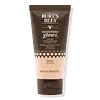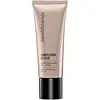Burt's Bees Goodness Glows Tinted Moisturizer Versus bareMinerals Complexion Rescue Tinted Hydrating Gel Cream SPF30
What's inside
What's inside
 Key Ingredients
Key Ingredients

 Benefits
Benefits

 Concerns
Concerns

 Ingredients Side-by-side
Ingredients Side-by-side

Water
Skin ConditioningGlyceryl Stearate
EmollientHeptyl Undecylenate
EmollientHelianthus Annuus Seed Oil
EmollientUndecane
EmollientIsoamyl Laurate
EmollientGlycerin
HumectantSqualane
EmollientPolyglyceryl-4 Caprate
EmulsifyingTridecane
PerfumingStearyl Alcohol
EmollientOctyldodecanol
EmollientCocos Nucifera Oil
MaskingEuterpe Oleracea Fruit Oil
Skin ConditioningCera Alba
EmollientJojoba Esters
EmollientCetearyl Alcohol
EmollientPolyglyceryl-3 Stearate
EmulsifyingPotassium Stearate
CleansingLecithin
EmollientXanthan Gum
EmulsifyingParfum
MaskingSodium Phytate
Trihydroxystearin
Skin ConditioningAlumina
AbrasiveSilica
AbrasiveTocopherol
AntioxidantAlcohol
AntimicrobialPotassium Sorbate
PreservativePhenoxyethanol
PreservativeCitronellol
PerfumingIron Oxides
CI 77891
Cosmetic ColorantWater, Glyceryl Stearate, Heptyl Undecylenate, Helianthus Annuus Seed Oil, Undecane, Isoamyl Laurate, Glycerin, Squalane, Polyglyceryl-4 Caprate, Tridecane, Stearyl Alcohol, Octyldodecanol, Cocos Nucifera Oil, Euterpe Oleracea Fruit Oil, Cera Alba, Jojoba Esters, Cetearyl Alcohol, Polyglyceryl-3 Stearate, Potassium Stearate, Lecithin, Xanthan Gum, Parfum, Sodium Phytate, Trihydroxystearin, Alumina, Silica, Tocopherol, Alcohol, Potassium Sorbate, Phenoxyethanol, Citronellol, Iron Oxides, CI 77891
Water
Skin ConditioningCoconut Alkanes
EmollientPropanediol
SolventTitanium Dioxide
Cosmetic ColorantSqualane
EmollientSorbitan Sesquiisostearate
EmulsifyingIsostearic Acid
CleansingPolysorbate 60
EmulsifyingTrehalose
HumectantGlycerin
HumectantAgar
MaskingSilica
AbrasiveMoringa Oleifera Seed Extract
Skin ConditioningSalicornia Herbacea Extract
Skin ConditioningMelilotus Officinalis Extract
AstringentTheobroma Cacao Seed Extract
AntioxidantCoco-Caprylate/Caprate
EmollientCaprylic/Capric Triglyceride
MaskingCaffeine
Skin ConditioningLauroyl Lysine
Skin ConditioningSuccinoglycan
Skin ConditioningAluminum Hydroxide
EmollientHydrogen Dimethicone
Citric Acid
BufferingDisodium Phosphate
BufferingAcetyl Tetrapeptide-5
HumectantButylene Glycol
HumectantPolyglyceryl-4 Laurate/Succinate
Cellulose Gum
Emulsion StabilisingMagnesium Chloride
Calcium Chloride
AstringentPotassium Chloride
Sodium Hyaluronate
HumectantMagnesium Stearate
Cosmetic ColorantPhenoxyethanol
PreservativeMica
Cosmetic ColorantCI 77491
Cosmetic ColorantCI 77492
Cosmetic ColorantCI 77499
Cosmetic ColorantCI 77891
Cosmetic ColorantWater, Coconut Alkanes, Propanediol, Titanium Dioxide, Squalane, Sorbitan Sesquiisostearate, Isostearic Acid, Polysorbate 60, Trehalose, Glycerin, Agar, Silica, Moringa Oleifera Seed Extract, Salicornia Herbacea Extract, Melilotus Officinalis Extract, Theobroma Cacao Seed Extract, Coco-Caprylate/Caprate, Caprylic/Capric Triglyceride, Caffeine, Lauroyl Lysine, Succinoglycan, Aluminum Hydroxide, Hydrogen Dimethicone, Citric Acid, Disodium Phosphate, Acetyl Tetrapeptide-5, Butylene Glycol, Polyglyceryl-4 Laurate/Succinate, Cellulose Gum, Magnesium Chloride, Calcium Chloride, Potassium Chloride, Sodium Hyaluronate, Magnesium Stearate, Phenoxyethanol, Mica, CI 77491, CI 77492, CI 77499, CI 77891
 Reviews
Reviews

Ingredients Explained
These ingredients are found in both products.
Ingredients higher up in an ingredient list are typically present in a larger amount.
Ci 77891 is a white pigment from Titanium dioxide. It is naturally found in minerals such as rutile and ilmenite.
It's main function is to add a white color to cosmetics. It can also be mixed with other colors to create different shades.
Ci 77891 is commonly found in sunscreens due to its ability to block UV rays.
Learn more about CI 77891Glycerin is already naturally found in your skin. It helps moisturize and protect your skin.
A study from 2016 found glycerin to be more effective as a humectant than AHAs and hyaluronic acid.
As a humectant, it helps the skin stay hydrated by pulling moisture to your skin. The low molecular weight of glycerin allows it to pull moisture into the deeper layers of your skin.
Hydrated skin improves your skin barrier; Your skin barrier helps protect against irritants and bacteria.
Glycerin has also been found to have antimicrobial and antiviral properties. Due to these properties, glycerin is often used in wound and burn treatments.
In cosmetics, glycerin is usually derived from plants such as soybean or palm. However, it can also be sourced from animals, such as tallow or animal fat.
This ingredient is organic, colorless, odorless, and non-toxic.
Glycerin is the name for this ingredient in American English. British English uses Glycerol/Glycerine.
Learn more about GlycerinPhenoxyethanol is a preservative that has germicide, antimicrobial, and aromatic properties. Studies show that phenoxyethanol can prevent microbial growth. By itself, it has a scent that is similar to that of a rose.
It's often used in formulations along with Caprylyl Glycol to preserve the shelf life of products.
Silica, also known as silicon dioxide, is a naturally occurring mineral. It is used as a fine, spherical, and porous powder in cosmetics.
Though it has exfoliant properties, the function of silica varies depending on the product.
The unique structure of silica enhances the spreadability and adds smoothness, making it a great texture enhancer.
It is also used as an active carrier, emulsifier, and mattifier due to its ability to absorb excess oil.
In some products, tiny microneedles called spicules are made from silica or hydrolyzed sponge. When you rub them in, they lightly polish away dead skin layers and enhance the penetration of active ingredients.
Learn more about SilicaSqualane is an emollient that helps the skin hold onto moisture. It's an oily liquid that occurs naturally in certain types of fish and plant oils.
Because squalane boosts hydration in the skin, it also comes with plenty of benefits: it is an antioxidant and can help fight free radicals and skin damage. Squalane is also found to have a detoxifying effect when applied.
Squalane comes from squalene, which occurs naturally within the sebum of our skin. It is one of the oils our skin produces to keep itself hydrated. Squalane is the hydrogenated version of squalene and has a longer shelf life.
Research shows that squalane is non-irritating (even at 100% concentration).
In general, it's a fantastic ingredient. It does a great job at hydrating the skin, and it's suitable for those with sensitive skin.
The source of squalane may impact malassezia / fungal acne. This is because olive oil derived squalane can contain impurities such as fatty acids and plant waxes. Sugarcane derived squalane is recommended for anyone with malassezia concerns.
Is squalane vegan?
This depends on the source. Squalane can be derived from both plants and animals. Most squalane used in skincare comes from plants.
Please note: the source of squalane is only known if disclosed by the brand. We recommend reaching out to the brand if you have any questions about their squalane.
Read more about squalene with an "e".
Is squalane an oil?
Squalane is often called an oil, but it’s technically not; it’s a hydrocarbon, meaning it’s only made of carbon and hydrogen, unlike true oils which are triglycerides made of fatty acids and glycerol.
The term “oil-free” isn’t regulated, so companies can define it however they want. Some exclude all oils, while others just avoid mineral oil or comedogenic oils.
While some people avoid oils thinking they cause breakouts, the right kind of oil (or oil-like ingredient like squalane) can actually help balance and hydrate your skin. It’s worth testing out simple oils or squalane to see what works best for your skin.
Learn more about SqualaneWater. It's the most common cosmetic ingredient of all. You'll usually see it at the top of ingredient lists, meaning that it makes up the largest part of the product.
So why is it so popular? Water most often acts as a solvent - this means that it helps dissolve other ingredients into the formulation.
You'll also recognize water as that liquid we all need to stay alive. If you see this, drink a glass of water. Stay hydrated!
Learn more about Water